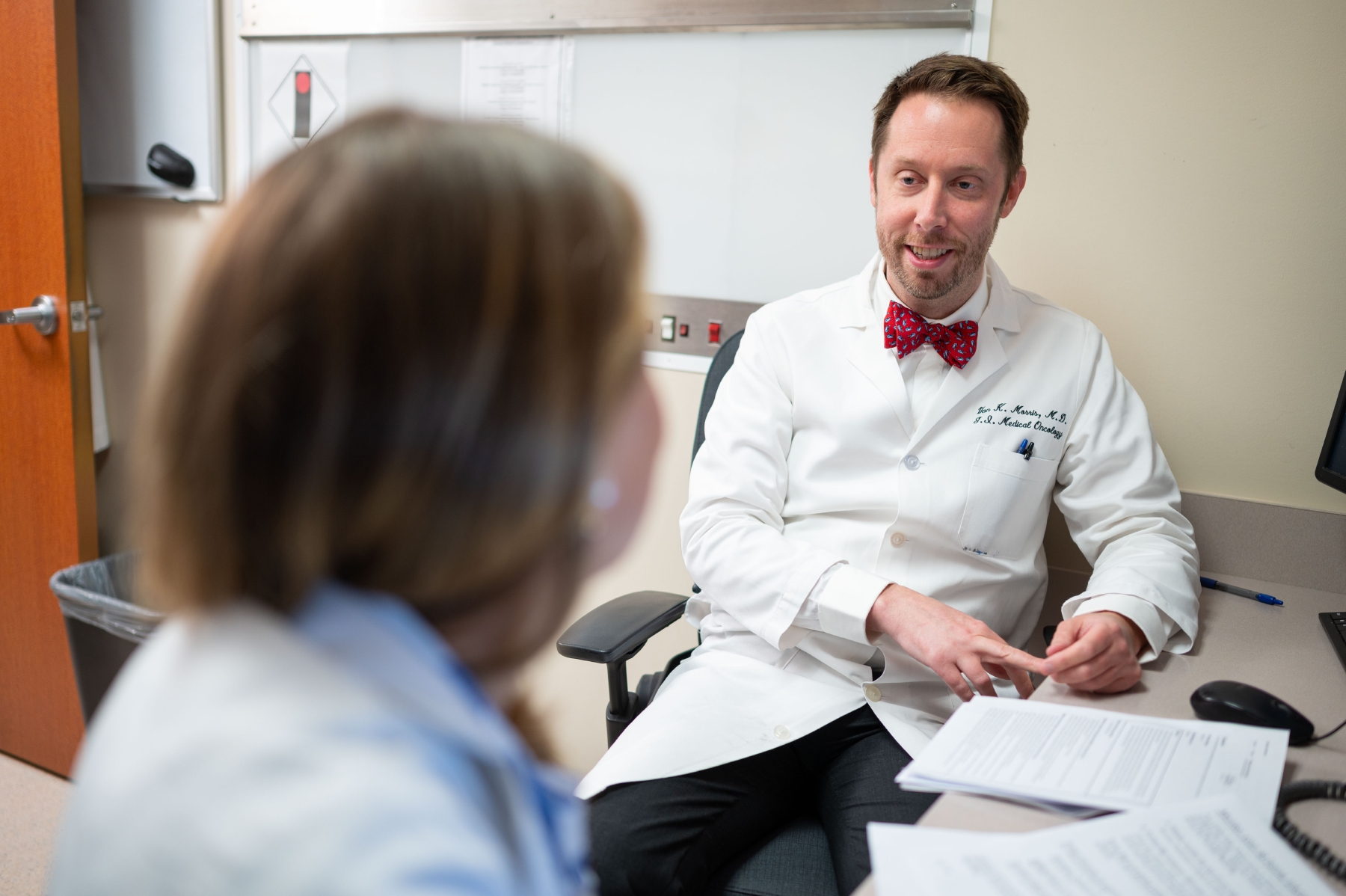- Diseases
- Acoustic Neuroma (14)
- Adrenal Gland Tumor (24)
- Anal Cancer (68)
- Anemia (2)
- Appendix Cancer (16)
- Bile Duct Cancer (28)
- Bladder Cancer (68)
- Brain Metastases (28)
- Brain Tumor (236)
- Breast Cancer (712)
- Breast Implant-Associated Anaplastic Large Cell Lymphoma (2)
- Cancer of Unknown Primary (4)
- Carcinoid Tumor (8)
- Cervical Cancer (158)
- Colon Cancer (166)
- Colorectal Cancer (106)
- Endocrine Tumor (4)
- Esophageal Cancer (40)
- Eye Cancer (36)
- Fallopian Tube Cancer (6)
- Germ Cell Tumor (4)
- Gestational Trophoblastic Disease (2)
- Head and Neck Cancer (2)
- Kidney Cancer (124)
- Leukemia (352)
- Liver Cancer (50)
- Lung Cancer (290)
- Lymphoma (286)
- Mesothelioma (14)
- Metastasis (30)
- Multiple Myeloma (102)
- Myelodysplastic Syndrome (64)
- Myeloproliferative Neoplasm (4)
- Neuroendocrine Tumors (16)
- Oral Cancer (102)
- Ovarian Cancer (176)
- Pancreatic Cancer (172)
- Parathyroid Disease (2)
- Penile Cancer (16)
- Pituitary Tumor (6)
- Prostate Cancer (148)
- Rectal Cancer (58)
- Renal Medullary Carcinoma (6)
- Salivary Gland Cancer (14)
- Sarcoma (234)
- Skin Cancer (294)
- Skull Base Tumors (54)
- Spinal Tumor (12)
- Stomach Cancer (58)
- Testicular Cancer (28)
- Throat Cancer (92)
- Thymoma (6)
- Thyroid Cancer (98)
- Tonsil Cancer (32)
- Uterine Cancer (78)
- Vaginal Cancer (14)
- Vulvar Cancer (18)
- Cancer Topic
- Adolescent and Young Adult Cancer Issues (20)
- Advance Care Planning (8)
- Biostatistics (2)
- Blood Donation (16)
- Bone Health (8)
- COVID-19 (362)
- Cancer Recurrence (120)
- Childhood Cancer Issues (120)
- Clinical Trials (624)
- Complementary Integrative Medicine (22)
- Cytogenetics (2)
- DNA Methylation (4)
- Diagnosis (220)
- Epigenetics (6)
- Fertility (62)
- Follow-up Guidelines (2)
- Health Disparities (14)
- Hereditary Cancer Syndromes (122)
- Immunology (18)
- Li-Fraumeni Syndrome (8)
- Mental Health (116)
- Molecular Diagnostics (8)
- Pain Management (64)
- Palliative Care (8)
- Pathology (10)
- Physical Therapy (18)
- Pregnancy (18)
- Prevention (870)
- Research (402)
- Second Opinion (74)
- Sexuality (16)
- Side Effects (600)
- Sleep Disorders (10)
- Stem Cell Transplantation Cellular Therapy (216)
- Support (402)
- Survivorship (322)
- Symptoms (180)
- Treatment (1760)
Leukemia treatment teaches survivor how to live in the moment
3 minute read | Published January 23, 2018
Medically Reviewed | Last reviewed by an MD Anderson Cancer Center medical professional on January 23, 2018
Dana MacFarlane is still in awe of her sudden onset of acute myeloid leukemia in July 2017.
“I take blood tests on a routine basis because I get hormone therapy, and the week before I got diagnosed, my white blood cell count was normal,” she says. “My white blood cells started spewing out the week I got sick. It happened just like that.”
In fact, Dana had spent the past summer eating clean foods and exercising vigorously. At 48, she was the fittest she’d ever been. Then in late July, she developed a fever and started experiencing abnormal chest pains. At first, she attributed the symptoms to a colonoscopy and endoscopy she’d just undergone. But eventually, her chest pain became too intense to ignore.
Coming to MD Anderson for acute myeloid leukemia treatment
Dana went to the emergency room, where the doctors first did an EKG to make sure it wasn’t her heart. Afterwards, they did a blood test, which immediately showed her white cells were out of control. “The doctors immediately called MD Anderson before I even knew what was going on and said we have a situation that’s beyond our control, and MD Anderson said get her down here by ambulance tonight,” Dana recalls.
Dana was transported from the hospital in Nederland, Texas, to the MD Anderson Emergency Center, where a care team was waiting for her. She started chemotherapy right away, and Courtney DiNardo, M.D., prepared her for what was to come.
“Dr. DiNardo told me I would lose my hair and discussed the side effects I needed to look for,” Dana recalls. “She said it’s going to take every bit of strength that you have to get through this but said, ‘You’re going to do OK.’”
Coping with the side effects of a stem cell transplant
DiNardo was right. Dana lost her hair, but she went into remission just 28 days after her first chemotherapy infusion. However, she still needed to complete a second round and undergo a stem cell transplant in order to reduce her chances of a recurrence. So on Nov. 1, 2017, Dana received the stem cells that her brother had donated.
“It’s a mental battlefield to say the least,” she says of her transplant experience. “If you don’t have somewhere to go and somewhere to take those thoughts, it’s going to be rough. Personally, that’s where my faith came in.”
The chemotherapy cocktail of Busulfan, Cladribine and Fludarabine that Dana had taken before her transplant caused diarrhea, vomiting, thrush on the inside of her mouth and esophagus; it also burned her skin in sensitive areas. However, she was determined to do everything she could to recover.
“I heard so many people wouldn’t eat and they lost their strength, so I made myself eat as much as I could stand. Even if it took two hours to take down a protein drink, I did it,” she says. “The nurses also encouraged me to get up and walk around. Sometimes, getting up meant sitting on the side of my bed.”
And when she hit her lowest points, she turned to her family and faith.
“Each of my girls had picked scripture that dealt with God’s strength. They picked scriptures that dealt with suffering and how momentary it is compared to eternity, and I remember clinging to those words,” she says.
Embracing every moment after leukemia treatment
Dana stayed in the hospital for 20 days after her stem cell transplant, though she’s still receiving blood and fluids. But with the worst of her treatment behind her, she’s embracing life with renewed sense of purpose.
“It’s not worth it to be angry for a day, especially at someone we love,” she says. “When we are in today, that’s all we’re promised, so we’ve got to live in the moment and be thankful we have it.”
Request an appointment at MD Anderson online or by calling 1-833-587-2617.
Related Cancerwise Stories

We’ve got to live in the moment and be thankful we have it.
Dana MacFarlane
Survivor





